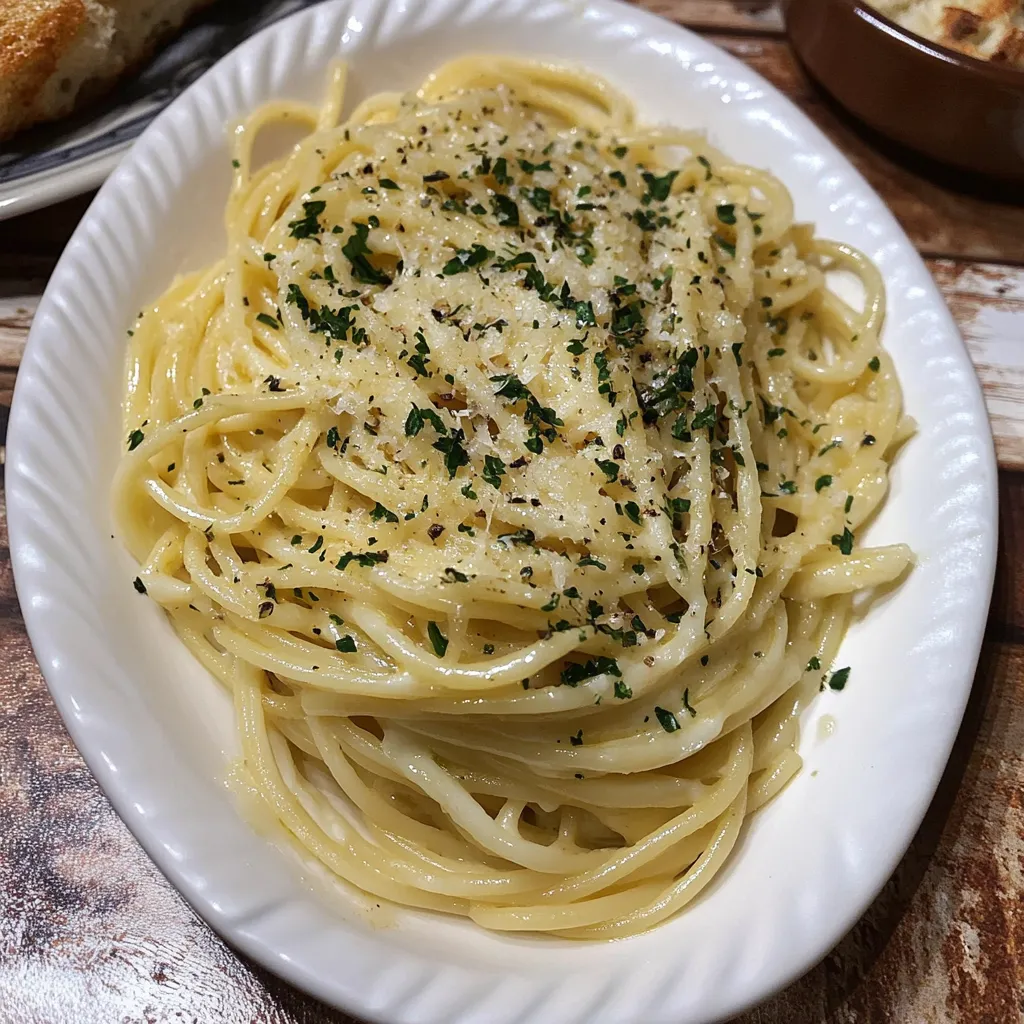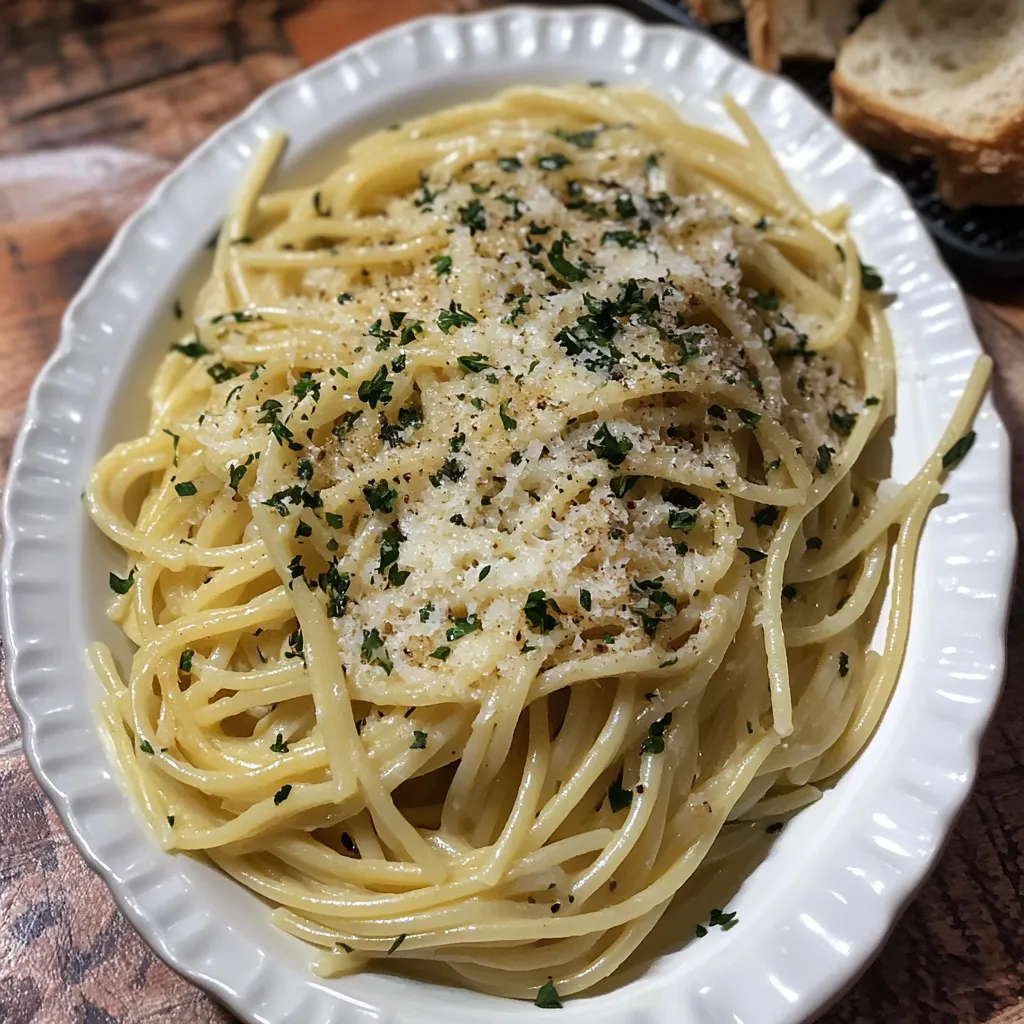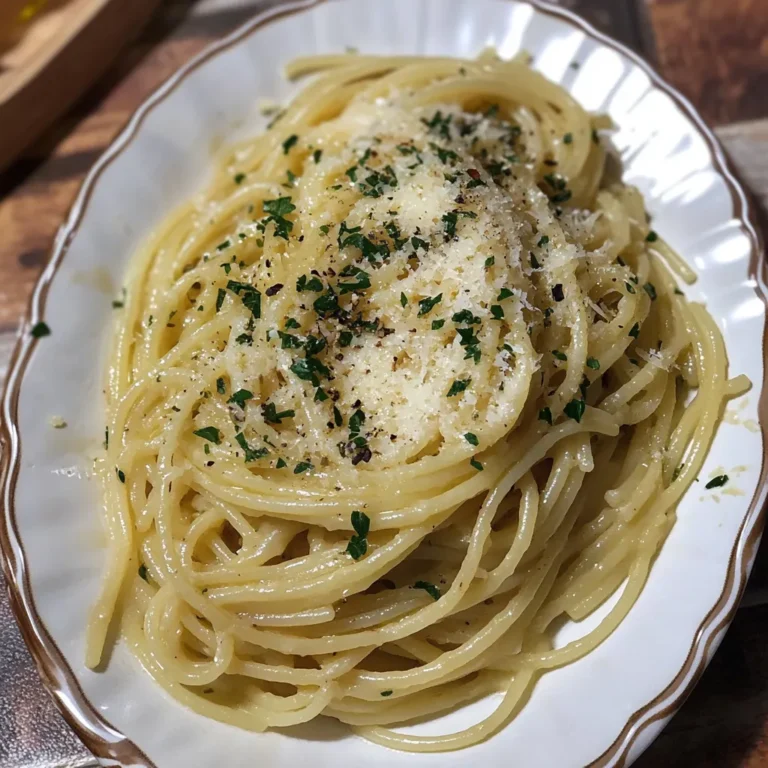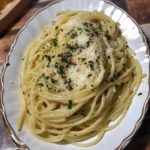Introduction to Pasta Aglio e Olio
If you’re a lover of Italian cuisine, you’ve likely heard of Pasta Aglio e Olio, a dish celebrated for its simplicity and incredible flavor. Originating in the heart of Naples, this pasta recipe is a perfect example of how humble ingredients can create a gourmet experience. Whether you’re a seasoned chef or a novice in the kitchen, this dish is accessible to all skill levels, making it a staple in households worldwide.
A Brief History of Aglio e Olio
The name Aglio e Olio literally translates to “garlic and oil” in Italian, highlighting its two primary ingredients. Rooted in the Southern Italian tradition of cucina povera, or “poor cooking,” this dish was designed to make the most of pantry staples without compromising on flavor. Its history intertwines with Naples’ culinary heritage, where garlic, olive oil, and pasta reign supreme.
To learn more about the origins of this iconic dish, check out this comprehensive guide on Italian pasta history. This source dives deeper into how Aglio e Olio became a beloved recipe over centuries.
Why is Pasta Aglio e Olio So Popular?
There’s a reason this dish is a favorite across the globe:
- Simplicity: It requires only a handful of ingredients, most of which you probably already have in your kitchen.
- Affordability: Made from accessible, inexpensive staples like spaghetti, garlic, and olive oil, it’s budget-friendly.
- Versatility: It can be dressed up with additional ingredients like parsley, lemon juice, or even proteins like shrimp.
- Health Benefits: With its use of extra-virgin olive oil and garlic, it aligns well with the principles of the Mediterranean diet.
For tips on selecting the right olive oil to enhance the dish’s flavors, visit this expert guide on high-quality olive oils.
What Makes It a Staple Recipe?
Pasta Aglio e Olio is a timeless dish that stands out for its:
- Ease of preparation: It’s perfect for busy weeknights when you need a quick yet satisfying meal.
- Rich yet light flavor profile: The roasted garlic and extra-virgin olive oil create a harmonious blend that coats the pasta beautifully.
- Cultural significance: Beyond its taste, the recipe carries the heritage of Italian home cooking, connecting people to a centuries-old tradition.
With a legacy steeped in Italian history and an undeniable universal appeal, Pasta Aglio e Olio is more than just a dish—it’s a celebration of the art of simplicity in cooking. Prepare to unlock the secrets to this timeless recipe in the following sections!

Ingredients Overview for Pasta Aglio e Olio
Creating the perfect Pasta Aglio e Olio begins with selecting the finest ingredients. Each component plays a pivotal role in achieving the dish’s iconic flavor and texture. Let’s break down the essentials and explore how to choose and substitute ingredients to suit your taste and dietary needs.
Spaghetti
The foundation of this dish is, of course, spaghetti. When deciding between dried and fresh, dried spaghetti is the traditional choice for its ability to hold up well against the olive oil-based sauce. Look for high-quality options made from durum wheat for the perfect al dente texture. Not sure how to cook it just right? Check out this guide to mastering al dente pasta.
Olive Oil
The quality of extra-virgin olive oil can make or break your dish. It’s essential to use a fresh, high-quality oil for its fruity and robust flavor. This ingredient not only coats the pasta but also forms the base of the sauce, binding the flavors together. If you’re unsure how to pick the best olive oil, this expert advice is a great place to start.
Garlic
Thinly slicing garlic is a skill that can elevate this recipe. By cutting it into slivers, you ensure that it browns evenly and infuses the oil with its nutty aroma. Be mindful not to overcook the garlic, as burnt garlic will impart a bitter taste.
Crushed Red Pepper Flakes
This ingredient brings a subtle heat to balance the richness of the oil and garlic. Adjust the quantity based on your spice tolerance, or leave it out entirely for a milder version.
Parsley, Lemon Juice, and Parmesan Cheese
- Parsley adds a pop of color and a fresh, herbaceous note to the dish.
- A squeeze of lemon juice brightens the flavors, cutting through the richness of the oil.
- Parmesan cheese lends a savory depth, rounding out the dish with its umami flavor.
Substitutions and Alternatives
- For a vegan version, omit Parmesan or use nutritional yeast as a substitute.
- Gluten-free spaghetti can easily replace traditional pasta for those with dietary restrictions.
- Swap parsley for fresh basil if desired, or add kale for extra nutrients.
Each of these ingredients contributes to making Pasta Aglio e Olio the flavorful and versatile dish it’s renowned for, while allowing for creative adaptations to meet diverse needs.
Essential Cooking Equipment for Pasta Aglio e Olio
To make the perfect Pasta Aglio e Olio, having the right kitchen tools is crucial. High-quality utensils not only make the cooking process smoother but also ensure the dish comes out flawless.
Must-Have Cooking Tools
- Pasta Pot: A large pot is essential for boiling spaghetti evenly. It allows enough space for the pasta to move freely and cook uniformly. Remember to heavily salt the water for flavor.
- Large Pan: Use a wide, shallow pan to prepare the garlic and olive oil sauce. The surface area helps the oil heat evenly and makes tossing the pasta easier.
- Slotted Spoon: This tool is perfect for reserving pasta water, a key ingredient in creating a cohesive sauce.
- Tongs: Ideal for tossing spaghetti in the pan, ensuring every strand is coated with the flavorful sauce.
Investing in good-quality utensils improves efficiency and consistency. For example, a heavy-bottomed pan retains heat better, preventing the garlic from burning. For additional tips on choosing durable cookware, explore this comprehensive cookware guide. These tools transform a simple recipe into a gourmet experience!
The Science of Flavors in Aglio e Olio
One of the reasons Pasta Aglio e Olio is so beloved is its ability to transform simple ingredients into a rich, flavorful dish. Understanding the science behind this recipe can elevate your cooking and deepen your appreciation for its delicate balance of flavors.
The Role of Garlic
When garlic is sautéed in extra-virgin olive oil, a remarkable transformation occurs. The heat breaks down its sulfur compounds, which are responsible for its pungent raw taste. As it cooks, garlic develops a sweet, nutty flavor, infusing the oil with its aroma. To avoid bitterness, keep the heat at a medium-low level and stir frequently. Burnt garlic can overpower the dish, so timing is key.
The Magic of Starchy Pasta Water
Starchy pasta water is the unsung hero of Aglio e Olio. As the pasta cooks, it releases starch into the boiling water. When added to the olive oil and garlic, this starchy water acts as an emulsifier, binding the sauce to the pasta. It creates a silky, cohesive texture that elevates the dish from oily to luxurious. Curious about how starch enhances sauces? Learn more from this expert analysis on pasta water.
Balancing Richness with Acidity and Spice
- Lemon juice adds acidity, cutting through the richness of the oil and garlic.
- Crushed red pepper flakes bring subtle heat, balancing the flavors and adding depth.
- A sprinkle of Parmesan cheese enhances the dish with its savory umami.
Together, these elements create a harmonious flavor profile that makes Pasta Aglio e Olio a timeless classic.

Step-by-Step Guide to Cooking Pasta Aglio e Olio
Mastering Pasta Aglio e Olio lies in perfecting each step, from cooking the pasta to creating the sauce and finishing with the right garnishes. Follow this detailed guide to achieve an authentic, restaurant-quality dish at home.
1. Cooking the Pasta
The foundation of any great pasta dish is perfectly cooked pasta. For Aglio e Olio, achieving an al dente texture is critical—it provides the right bite and absorbs the sauce without becoming mushy.
Steps for Perfect Pasta
- Use a large pot filled with well-salted water (it should taste like the sea).
- Bring the water to a rolling boil before adding the spaghetti.
- Stir occasionally to prevent sticking, and cook for 8–10 minutes or as directed on the package.
Reserve 1 cup of starchy pasta water before draining. This liquid is key to emulsifying the sauce and binding it to the pasta. For more on why pasta water is essential, check out this in-depth guide.
2. Preparing the Sauce
The sauce in Aglio e Olio is deceptively simple yet incredibly flavorful. It’s all about timing and technique to coax out the best from your ingredients.
Heating Olive Oil
- In a large, wide pan, heat ¾ cup of extra-virgin olive oil over medium-low heat. The oil should be warm but not smoking, as overheating can degrade its flavor.
Golden-Browning Garlic
- Add 12 thinly sliced garlic cloves to the oil. Stir frequently, ensuring even cooking. The garlic should turn golden brown, releasing its nutty aroma. Be careful—garlic burns quickly, which results in a bitter taste.
Adding Crushed Red Pepper Flakes
- Sprinkle in 2 teaspoons of crushed red pepper flakes to the pan, adjusting the amount based on your spice preference. This step adds a subtle heat that balances the richness of the oil.
3. Combining Pasta and Sauce
Once the garlic and oil are ready, it’s time to marry the sauce with the spaghetti.
Tossing the Pasta
- Add the cooked spaghetti to the pan with the garlic oil. Use tongs to toss the pasta, ensuring every strand is coated.
Incorporating Pasta Water
- Gradually add the reserved pasta water, 1–2 tablespoons at a time. This creates a glossy, cohesive sauce that clings to the pasta. The starch in the water binds with the oil, transforming the mixture from oily to silky.
4. Finishing Touches
The final steps bring brightness and depth to the dish.
Adding Parsley, Lemon Juice, and Parmesan Cheese
- Remove the pan from the heat and stir in:
- ⅓ cup finely chopped parsley for a fresh, herbaceous touch.
- 2 tablespoons fresh lemon juice to balance the richness.
- ½ cup freshly grated Parmesan cheese, which melts slightly and adds savory umami.
Adjusting Seasonings
- Taste the dish and adjust with additional salt, black pepper, or lemon juice as needed.
Advanced Tips for Perfection
- Burnt garlic rescue: If your garlic turns too dark, start over. Burnt garlic imparts a bitter taste that can’t be masked.
- Gluten-free option: Substitute with gluten-free spaghetti; the cooking process remains the same.
- Extra flavor boost: Add anchovies or sautéed shrimp for a protein-rich twist.
By following these steps, you’ll create a dish that’s simple yet packed with flavor—a true testament to the beauty of Pasta Aglio e Olio.
Common Mistakes to Avoid When Making Pasta Aglio e Olio
While Pasta Aglio e Olio is simple to prepare, a few common mistakes can compromise the dish’s flavor and texture. Avoid these pitfalls to ensure your pasta turns out perfectly every time.
1. Burning Garlic
Burnt garlic is one of the quickest ways to ruin this dish. Overcooking garlic turns it bitter and overpowering, masking the subtle flavors of extra-virgin olive oil.
How to Prevent It
- Always cook garlic over medium-low heat to allow it to brown gently.
- Stir frequently to ensure even cooking.
- Remove the pan from heat immediately once the garlic turns golden brown. If it burns, start over—there’s no saving burnt garlic.
2. Overcooking Pasta
Al dente pasta is essential for Aglio e Olio. Overcooked pasta becomes mushy and won’t absorb the sauce effectively.
Timing is Key
- Follow the package instructions but start testing your pasta 1–2 minutes before the recommended time.
- Aim for a firm bite, as the pasta will cook slightly more when tossed in the hot sauce.
Learn more about perfect pasta cooking from this step-by-step pasta guide.
3. Using Low-Quality Olive Oil
The olive oil is the heart of this dish, and using a low-quality version can result in a bland or greasy flavor.
Why It Matters
- High-quality extra-virgin olive oil adds a fruity, peppery richness that elevates the dish.
- Avoid refined or light olive oils, which lack the depth of flavor needed.
For tips on choosing the best olive oil, visit this olive oil selection guide.
4. Skipping Pasta Water
The starchy pasta water is a vital ingredient that emulsifies the oil and creates a cohesive sauce. Without it, your pasta may feel greasy and disconnected.
Always Save It
- Before draining, reserve at least 1 cup of pasta water.
- Add it gradually to the pan, tossing the pasta to achieve a silky texture.
By avoiding these common mistakes, you’ll ensure your Pasta Aglio e Olio is flavorful, balanced, and perfectly cooked every time.

Variations of Pasta Aglio e Olio
Pasta Aglio e Olio is a versatile dish that lends itself to endless customization. Whether you’re looking to add protein, make it vegan, or adapt it to dietary restrictions, these variations ensure everyone can enjoy this classic recipe.
1. Add-Ins for Extra Flavor
Elevate your Aglio e Olio by incorporating these delicious add-ins:
- Shrimp: Sauté peeled shrimp in olive oil with garlic until pink, then toss with the pasta for a seafood twist.
- Anchovies: Add finely chopped anchovies to the garlic and oil for a savory, umami-packed flavor.
- Kale or Spinach: Toss in a handful of greens like kale or spinach, letting them wilt in the hot pan for added nutrients and color.
These ingredients not only boost flavor but also make the dish more filling and nutritionally balanced.
2. Vegan Version
For a vegan twist:
- Omit the Parmesan cheese and replace it with nutritional yeast, which mimics the cheesy, nutty flavor.
- Add roasted nuts or toasted breadcrumbs for a crunchy topping.
Explore more plant-based cooking options in this vegan recipe guide.
3. Gluten-Free Adaptation
Enjoy Aglio e Olio gluten-free by substituting traditional spaghetti with gluten-free pasta made from rice, quinoa, or chickpeas. These alternatives retain the dish’s integrity while catering to dietary needs.
With these variations, Pasta Aglio e Olio becomes a customizable canvas for diverse tastes and dietary preferences while staying true to its roots of simplicity and flavor.
Serving Suggestions and Pairings for Pasta Aglio e Olio
Pasta Aglio e Olio shines as a standalone dish, but pairing it with complementary sides and beverages can elevate your meal into a well-rounded dining experience. Here are some perfect accompaniments to enhance the flavors of this classic recipe.
1. Ideal Side Dishes
To balance the richness of the pasta, consider these light and flavorful sides:
- Garlic Bread: A crispy, buttery loaf infused with garlic complements the pasta’s savory notes while adding texture.
- Fresh Salads: A simple salad with arugula, lemon vinaigrette, and cherry tomatoes provides acidity and a refreshing counterpoint.
- Soups: Light broths or minestrone soup bring warmth and additional layers to your meal.
For more inspiration on Italian-inspired sides, check out this comprehensive side dish guide.
2. Wine Pairings
The delicate, garlicky flavors of Aglio e Olio pair beautifully with light, fruity wines:
- Pinot Grigio: Its crisp, citrusy notes balance the oil’s richness.
- Sauvignon Blanc: Offers herbal undertones that complement the parsley and lemon in the dish.
- Chardonnay: A lightly oaked version adds a hint of creaminess without overpowering the pasta.
Pairing the right wine enhances the dish’s subtle flavors, making for a sophisticated dining experience. Explore more wine options in this wine pairing guide.
With these sides and pairings, Pasta Aglio e Olio transforms into a meal that’s not only satisfying but also memorable.
FAQs: Addressing Common Queries About Pasta Aglio e Olio
1. How Do I Store Leftovers?
- Store leftover Pasta Aglio e Olio in an airtight container in the refrigerator for up to 3 days.
- Reheat gently in a pan over medium heat with a splash of water or olive oil to restore its creamy texture.
2. Can This Dish Be Made in Advance?
Yes, but it’s best enjoyed fresh. To prepare in advance:
- Cook the pasta and sauce separately. Combine and reheat when ready to serve.
- Avoid adding parsley or Parmesan until just before serving to maintain freshness.
For more meal-prep ideas, visit this make-ahead pasta guide.
3. What Other Oils Can I Use If I Don’t Have Olive Oil?
While extra-virgin olive oil is ideal, you can use:
- Avocado oil: Offers a mild, buttery flavor.
- Grapeseed oil: Neutral and light, it works well in a pinch.
However, avoid heavily flavored oils like sesame or coconut, as they can overpower the dish. Learn more about oil substitutions in this oil selection guide.
By addressing these common concerns, you can enjoy Pasta Aglio e Olio with confidence, no matter the situation!
PrintHow to Perfect Pasta Aglio e Olio: Step-by-Step Recipe, Tips, and Pairings
A classic Italian dish combining spaghetti with garlic, olive oil, red pepper flakes, parsley, and Parmesan for a flavorful, simple meal.
- Prep Time: 5 minutes
- Cook Time: 15 minutes
- Total Time: 20 minutes
- Yield: 4 servings
- Category: Main Course
- Method: Stovetop
- Cuisine: Italian
- Diet: Vegetarian
Ingredients
– 1 pound dried spaghetti
– ¾ cup extra-virgin olive oil
– 12 garlic cloves, sliced
– 2 tsp crushed red pepper flakes
– ⅓ cup fresh parsley, chopped
– 2 tbsp fresh lemon juice
– ½ cup Parmesan cheese
– Salt and pepper to taste
Instructions
1. Boil pasta in salted water until al dente, reserving 1 cup of pasta water.
2. Heat olive oil in a pan, sauté garlic until golden brown.
3. Add red pepper flakes, then toss in cooked pasta.
4. Stir in pasta water for a silky sauce.
5. Remove from heat and mix in parsley, lemon juice, and Parmesan.
6. Adjust seasoning, garnish, and serve.
Notes
– Avoid burning garlic; cook on medium-low heat.
– Use freshly grated Parmesan for the best flavor.
– Customize with add-ins like shrimp or kale.
Nutrition
- Serving Size: 1
- Calories: 450
- Sodium: 300mg
- Fat: 20g
- Carbohydrates: 55g
- Fiber: 3g
- Protein: 12g
- Cholesterol: 10mg


